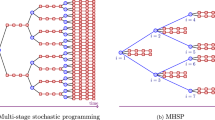Abstract
This paper concerns distributed convex optimization problems over time-varying undirected graphs, in which the global objective function is expressed as the sum of individual objective functions of the agents. Each agent only knows its local objective functions. To figure out such problems, an event-triggered asynchronous distributed optimization algorithm (termed as EV-ADOA) with time-varying heterogeneous step-sizes is proposed, which is suitable for undirected graphs changing over time. Under two standard assumptions on strongly convex and smoothness of local objective functions, the EV-ADOA can achieve linear convergence with a proper upper bound of the heterogeneous time-varying step-sizes. EV-ADOA with event-triggered scheme can decrease network communication, and the Zeno-like behavior strictly is excluded. The efficiency of EV-ADOA is demonstrated by experiments.






Similar content being viewed by others
References
Song X, Wang C, Gao J (2013) DLRDG: distributed linear regression-based hierarchical data gathering framework in wireless sensor network. Neural Comput Appl 23(7–8):1999–2013
Chen J, Sayed A (2012) Diffusion adaptation strategies for distributed optimization and learning over networks. IEEE Trans Signal Process 60(8):4289–4305
Hasan H, Abdulkareem S (2014) Retraction note to: Human–computer interaction using vision-based hand gesture recognition systems: a survey. Neural Comput Appl 25(2):251–261
Li N, Chen L, Dahleh M (2015) Demand response using linear supply function bidding. IEEE Trans Smart Grid 6(4):1827–1838
Ma A, Gao Y, Huang L (2017) Improved differential search algorithm based dynamic resource allocation approach for cloud application. Neural Comput Appl. https://doi.org/10.1007/s00521-017-3280-5
Predd J, Kulkarni S, Poor H (2009) A collaborative training algorithm for distributed learning. IEEE Trans Inf Theory 55(4):1856–1871
Angelov P, Sadeghitehran P, Clarke C (2017) AURORA: autonomous real-time on-board video analytics. Neural Comput Appl 28(5):855–865
Dong X, Zhou Y, Ren Z, Zhong Y (2017) Time-varying formation tracking for second-order multi-agent systems subjected to switching topologies with application to quadrotor formation flying. IEEE Trans Ind Electron 64(6):5014–5024
Dong X, Zhou Y, Ren Z, Zhong Y (2018) Theory and experiment on formation-containment control of multiple multirotor unmanned serial vehicle systems. IEEE Trans Autom Sci Eng. https://doi.org/10.1109/TASE.2018.2792327
Hosseini A (2016) A non-penalty recurrent neural network for solving a class of constrained optimization problems. Neural Netw 73:10–25
Li G, Yan Z, Wang J (2015) A one-layer recurrent neural network for constrained nonconvex optimization. Neural Netw 61:10–21
He W, Qian F, James L, Chen G, Han Q, Kurthsf J (2015) Quasi-synchronization of heterogeneous dynamic networks via distributed impulsive control: error estimation, optimization and design. Automatica 62:249–262
Xu B, He W (2018) Event-triggered cluster consensus of leader-following linear multi-agent systems. J Artif Intell Soft Comput Res 8(4):293–302
He W, Chen G, Zhong W, Qian F (2018) Secure impulsive synchronization control of multi-agent systems under deception attacks. Inf Sci 459:354–368
Lv S, He W, Qian F, Cao J (2018) Leaderless synchronization of coupled neural networks with the event-triggered mechanism. Neural Netw 105:316–327
Nedic A, Ozdaglar A (2009) Distributed subgradient methods for multi-agent optimization. IEEE Trans Autom Control 54(1):48–61
Nedic A, Olshevsky A (2015) Distributed optimization over time-varying directed graphs. IEEE Trans Autom Control 60(3):601–615
Nedic A, Olshevsky A, Shi W, Uribe C (2017) Geometrically convergent distributed optimization with uncoordinated step-sizes. In: American Control Conference, Seattle, WA, USA, pp 3950–3955
Xu J, Zhu S, Soh Y, Xie L (2018) Convergence of asynchronous distributed gradient methods over stochastic networks. IEEE Trans Autom Control 63(2):434–448
Srivastava K, Nedic A (2011) Distributed asynchronous constrained stochastic optimization. IEEE J Sel Topics Signal Process 5(4):772–790
Zanella F, Varagnolo D, Cenedese A, Pillonetto G, Schenato L (2012) Asynchronous Newton-Raphson consensus for distributed convex optimization. In: 3rd IFAC workshop on distributed estimation and control in networked systems, Santa Barbara, CA, USA, pp 133–138
Wei E, Ozdaglar A (2013) On the \(O(1/k)\) convergence of asynchronous distributed alternating direction method of multipliers. In: the 2013 IEEE Global Conference on Signal and Information Processing, Austin, TX, USA, pp 551–554
Iutzeler F, Bianchi P, Ciblat P, Hachem W (2013) Asynchronous distributed optimization using a randomized alternating direction method of multipliers. In: IEEE 52th annual conference on decision and control, Florence, pp 3671–3676
Jakovetic D, Moura J, Xavier J (2015) Linear convergence rate of a class of distributed augmented Lagrangian algorithms. IEEE Trans Autom Control 60(4):922–936
Zhu W, Jiang Z, Feng G (2015) Event-based consensus of multi-agent systems with general linear models. Automatica 50(2):552–558
He W, Xu C, Han Q, Qian F, Lang Z (2018) Finite-time \({\cal{L}_2}\) leader–follower consensus of networked Euler–Lagrange systems with external disturbances. IEEE Trans Syst Man Cybern Syst 48(11):1920–1928
Zhao M, Peng C, He W, Song Y (2017) Event-triggered communication for leader-following consensus of second-order multi-agent systems. IEEE Trans Cybern 48(6):1888–1897
He W, Chen G, Han Q, Du W, Cao J, Qian F (2017) Multiagent systems on multilayer networks: synchronization analysis and network design. IEEE Trans Cybern 47(2):327–338
Chen W, Ren W (2016) Event-triggered zero-gradient-sum distributed consensus optimization over directed networks. Automatica 65:90–97
Nedic A, Olshevsky A, Shi W (2017) Achieving geometric convergence for distributed optimization over time-varying graphs. SIAM J Control 27(4):2597–2633
Liu C, Yang Z, Sun D, Liu X, Liu W (2018) Stability of switched neural networks with time-varying delays. Neural Comput Appl 30(7):2229–2244
Acknowledgements
This work was supported in part by the National Key Research and Development Program of China under Grant 2016YFB0800601, in part by Australian Research Council under Grant DE160100675, in part by the National Natural Science Foundation of China under Grant 61472331, 61772434, and 61503310, and in part by Fundamental Research Funds for the Central Universities under Grant XDJK2016C103.
Author information
Authors and Affiliations
Corresponding authors
Additional information
Publisher’s Note
Springer Nature remains neutral with regard to jurisdictional claims in published maps and institutional affiliations.
Rights and permissions
About this article
Cite this article
Xie, T., Chen, G. & Liao, X. Event-triggered asynchronous distributed optimization algorithm with heterogeneous time-varying step-sizes. Neural Comput & Applic 32, 6175–6184 (2020). https://doi.org/10.1007/s00521-019-04116-w
Received:
Accepted:
Published:
Issue Date:
DOI: https://doi.org/10.1007/s00521-019-04116-w




